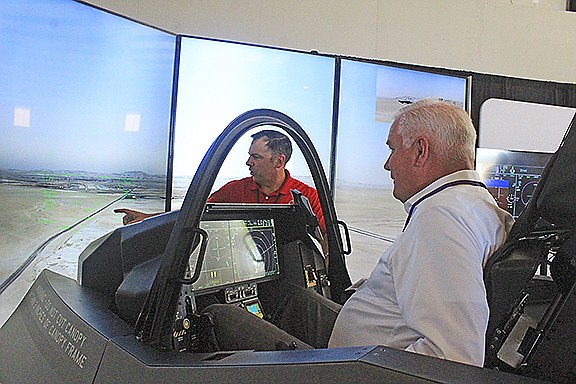FORT SMITH -- The Air Force is exploring the possible environmental impacts of placing a Foreign Military Sales Pilot Training Center at Ebbing Air National Guard Base.
The first of three Environmental Impact Statement public meetings was held Wednesday .
Ebbing at Fort Smith Regional Airport was selected last year as the Air Force's preferred location for a pilot training center for Singapore and other countries participating in the Foreign Military Sales program. The proposal would accommodate up to 24 foreign Lockheed Martin F-35 Lightning II aircraft and move 12 General Dynamics F-16 Fighting Falcons from the Singapore Air Force, currently at Luke Air Force Base in Glendale, Ariz.
While Ebbing is the preferred location, the Air Force chose Selfridge Air National Guard Base in Harrison Township, Mich., if the center couldn't be at Fort Smith for some reason.
David Martin, Environmental Impact Statement project manager from Air Force Civil Engineer Center, National Environmental Policy Act division, explained the purpose of the meeting was to present information on potential environmental impacts of the planes and receive public comments.
The policy act requires federal agencies to identify the affected environment, evaluate the potential environmental consequences and identify environmental permits and suggested mitigation measures to minimize environmental impacts, if required, Martin said.
"The process concludes with a record of decision, what's known as ROD, that identifies which alternative is selected and outlines any mitigation measures that are required," he said.
The Air Force is the lead agency for the proposed action and is responsible for the scope and content of the Environmental Impact Statement, and the Federal Aviation Administration is a cooperating agency because the scope of the proposed action involves activities under their jurisdiction by law.
The draft Environmental Impact Statement says Ebbing and Selfridge have several commonalities including the number of F-16 and F-35 aircraft they can accommodate, any flight operations could take place within existing air space without adding or altering configurations, the number of personnel would increase overall by about 384 with 800 dependents, and barrier arresting kits, F-35 simulator training facilities and other support facilities would need to be constructed or buildings retrofitted to support the Foreign Military Sales program.
Patrick Jeanes with Air Education Training and Command in San Antonio said the Air Force has Ebbing as its preferred location because it has previously accommodated F-16s and can accommodate the program with minimal renovation, new construction or displacement of current services.
The draft statement details the major renovations required for the Foreign Military Sales program at Ebbing, which includes installing arresting barriers at both ends of one of the runways, constructing a four- to eight-bay F-35 flight simulator training facility, building an up to 50,000-square-foot F-35 simulator training facility, altering or adding to the north side of a small F-16 simulator and an additional F-35 simulator training facility to accommodate the Singapore Air Force and removal and replacement of nine covered spaces with three F-35 three-bay sunshades.
The policy act also requires the Air Force to look at a no-action alternative, which would mean the Foreign Military Sales program wouldn't be relocated to a single, permanent location, Martin said.
The draft statement said taking no action would negatively impact the Air Force and multiple nation partners' abilities to train effectively as air space and F-35 simulator availability at Luke Air Force Base move to full capacity. Therefore, the statement looks at resource areas potentially impacted by the proposed action including noise, land use, environmental justice, children and elderly, biological resources and air quality. Other resources analyzed are socioeconomics, cultural resources, water resources, safety, soils and geology, hazardous and solid material/waste, infrastructure/transportation and air space.
Martin said there could be significant noise impacts that could disturb neighbors' sleep and interfere with events at local schools and other public areas. He said the noise would largely affect children and the elderly, especially if they are minority or low income living adjacent to Ebbing.
The Air Force is considering several measures to mitigate noise impacts, such as reducing the number of flying operations, adjusting the runway use patterns, increasing the distance between aircraft and noise-sensitive locations by increasing altitudes or adjusting routing, placing restrictions on late-night flying and limiting afterburner use.
The first impact meeting was held in Fort Smith. The second meeting will be held near Selfridge on Wednesday and the third will be online Oct. 5. Jennifer Piggott, the Air Force's moderator for the event, said the same content will be presented at each meeting, and is also available at www.fmsptceis.com.
Martin said once the impact meetings are over, the Air Force will review public comments and address them in the final Environmental Impact Statement, anticipated in early 2023. He said a final decision for the Foreign Military Sales location is expected next spring.
Jeanes said at a public meeting in February if Fort Smith is selected, residents can expect F-16s around June 2023 and the first F-35s in July 2024.
Several elected officials spoke in favor of having the program at Ebbing, including State Secretary of Commerce Mike Preston, State Director of Military Affairs Rob Ator, State Rep. Justin Boyd, Fort Smith Mayor George McGill, Greenwood Mayor Doug Kinslow and Fort Smith City Administrator Carl Geffken. Representatives of Oklahoma Gas & Electric, Fort Smith Public Schools, the University of Arkansas at Fort Smith and the Fort Smith Regional Airport also spoke about preparations to welcome military members and their families.
"So on behalf of our governor, our elected officials at every level, our communities and our hard-working Arkansans, I want to formally invite the United States Air Force to locate this mission in Fort Smith, Arkansas, and know that we are now more than ready and more than willing and more than able to succeed with our partners," Preston said. "And I'll leave you with this. To Fort Smith, the River Valley and the state of Arkansas, to us the sound of a fighter jet is the sound of freedom. Let freedom roar."
